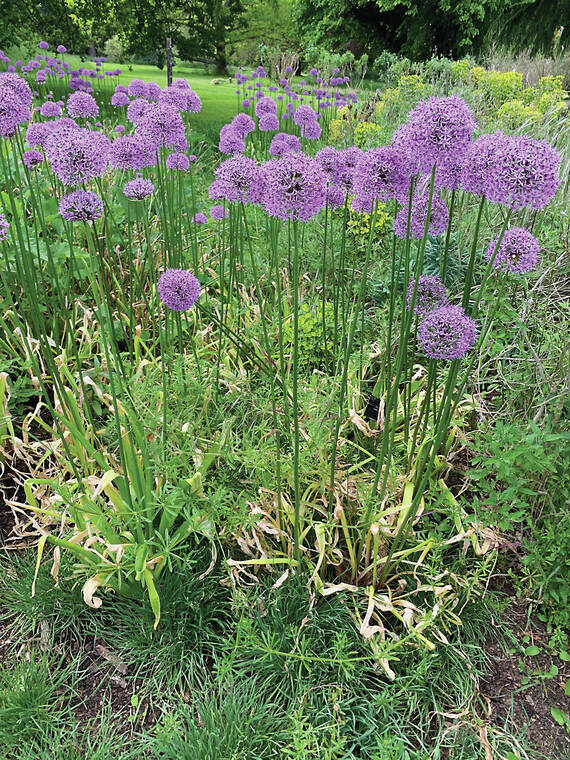We are home now but were recently in Harlem, New York City. This is where fresh herbs and spices are a natural for outdoor and kitchen gardening. In Hawaii we tend to depend on the convenience of the supermarkets, but growing your own can be fun as well as save money on the food budget.
We were amazed at the renaissance of Harlem, especially the interesting ethnic restaurants as well as how many folks are growing their community gardens.
Homegrown flavorful plants will add interest and piquant taste to the ordinary round of vegetables. Herbs also add a delightful tang to dressings for chicken, turkey, vegetarian and pork dishes.
Most herb plants are readily available at local garden shops. They will do well provided the soil is well-drained and has sufficient nutrients. Organic loam is ideal for many flavor plants.
Other herbs favor damp, shady spots. As an example, mint does well in a shady spot near a dripping faucet.
A spot for growing your own seasoning takes almost no area at all. Often, you can squeeze the plants into the open spaces between other plants, or along the border of the flowerbed. They can also be grown in pots on the lanai or even near a bright kitchen window.
Herbs for cooler areas are dill, coriander, anise, sage, sweet marjoram, thyme, lavender, rosemary and sweet fennel, but don’t plant that group in hot coastal areas unless you plan to give extra insect and disease control.
Warm weather types you may plant are basil, chives, oregano, summer savory, catnip, borage, lemon verbena, tarragon, mints, pot marjoram, citronella, vanilla orchid and edible ginger.
Basil is considered one of the finest spices for use in pickling. It is of two types, sweet green basil and the dwarf form. Just a few plants are sufficient for the needs of the average family. Sometimes one or two basil plants may be grown in a flower border. The leaves and flowers have a clove-like spicy flavor and are prized for use in many ways: in making spiced vinegar, pickles, gravies, soups, stews, salads, and in cooking meats and fish. Basil is an especially choice flavor to add to tomato dishes.
When dried and powdered, basil is used for spicing meat or other fish, sausage, liver paste and similar products. The flowers along with the tender tips of the stems with their foliage are cut, tied in very small bunches and dried.
The chive is the smallest member of the onion family. Its tiny bulbs grow in thick bunches, and its young tender leaves, that may be cut freely, have a delicate and pleasing flavor similar to a very mild onion. They add a gentle snap to salads and dressings, dry-bean dishes, jellied chicken, hot vegetables, omelets and other mixtures. The plant grows to a height of 6 or 8 inches with dark green, grass-like foliage and bears pretty, violet clusters of bloom. They should be used more often as ornamental border plants. Chives are propagated by dividing the clumps and resetting in the fall, preferably in rich soil. In New Zealand, folks believe a border of chives repels hungry insects and other critters.
Edible ginger, often confused with the common ornamental ginger, grows well in Hawaii and produces choice roots if given rich soil, sufficient moisture and semi shade. Ginger will long remain one of the world’s most popular spices and should be grown in every home garden. It is an erect herb, 12 to 24 inches high and canna-like in appearance. It grows from thickened rhizomes that branch finger-like and send up new shoots from the tips near the surface of the soil. If used for preserving or candying, the rhizomes should be dug while tender and succulent, rather than when old, tough and fibrous. Fresh green ginger is an indispensable part of chutneys, giving them much of their spiciness and pungent flavor.
Harvesting and curing of herbs and spices are the most important parts of the flavor growing hobby. The main point is to gather each plant at the proper stage of maturity and dry rapidly in a warm, dry place so that it will retain flavor and color. The water heater is a natural for this.
Herbs, when sufficiently dry, are crisp. Many of them are stored in powder form. Separate the leaves from the stalk before crushing into a powder. The knack for using herbs is often a well-guarded secret. Sunset’s “Herb Gardening” will help you with many of these growing secrets. The book is available at local garden stores and bookstores.
Some rules to follow in developing your own secrets include using a light hand with herbs. You want just enough flavor to compliment your dish, so you don’t crowd out the flavor of the food.
Be subtle with blends so that only you and an expert can tell which herbs you have used.
When using fresh herbs, chop very fine so that more of the herb oils can escape. Blending or heating with butter or salad oil is the best way to draw out and extend the flavor or herbs.
Soak dried herbs in a teaspoon of water or lime juice for 15 minutes before using.
For casseroles and sauces, add the finely chopped fresh or dried herbs directly to the mixture. Remember, a little does a lot.
For more information on herb and spice gardening, contact the UH Master Gardeners. In East Hawaii call (808) 981-5199 and in West Hawaii, call (808) 322-4893.
Norman Bezona is professor emeritus, University of Hawaii College of Tropical Agriculture and Human Resources.

